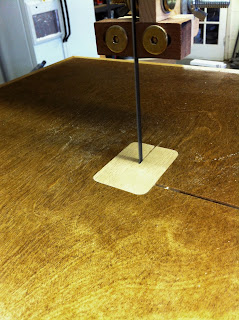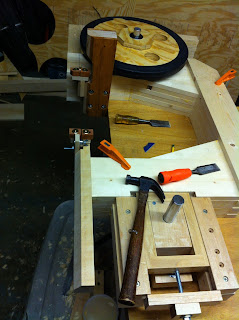I've followed most of the instructions and cut the dimensions as written up until now. I figured I'd customize the build a bit more and construct a neat table. I cut out the main center from 3/4" birch plywood, and stained it dark. I then applied a base coat of finishing epoxy (the same as my guitar) to seal the stain in before gluing the trim. The trim is just some strips of mitered maple. Seen here is right after gluing the maple.
I beveled the edges of the maple with a router. Afterwards, I applied more epoxy. The maple used looks quite nice.
Poo extraction clothes. Maple. Etc.
After about 3 coast of epoxy, I marked where the blade channel will be cut with the table saw along with the center hole for the blade to pass through.
A quick pass with the table saw and a few cuts with the bandsaw, the table begins to take its final position.
The trunions were screwed to the sub-table, and the sub-table and trunions were screwed to the table.
With the table on the trunions, the blade made contact with the table hole. This picture is from below the table, with the angle at 45 degrees. You can see the beveled notch I chiseled to fix the issue.
The 3/4" plywood sill bent enough whereas a piece of wood would bump the edge from this slot. A common remedy is to insert a bolt and nut centered on the groove. This will clamp the plywood level along the groove. It will be removed when the blade needs changed.
A view from below.
I set up some fences and routed a ~1/4" deep rabbet around the square opening. A few planed pieces of oak later, I have a zero-clearance insert. I made a few so I can replace them if necessary.
I've since resawed some 4" oak boards for fun. I can see this being of great use in the future. Here it is running.The epoxy finish is extremely durable and smooth. I'm not entirely sure what the benefits are compared to standard finishes like polyurethane, so time will tell. I'm assuming here that the epoxy is harder than most finishes.
I've recently purchased the lumber and hardware for the stand (the plans are, again, from woodgears.ca). The plans call for dovetail joints, which will be interesting because I've never done something like that before. I could always opt for a simple finger joint if I'm a sissy. We'll see.
Until next time.
-A.







































